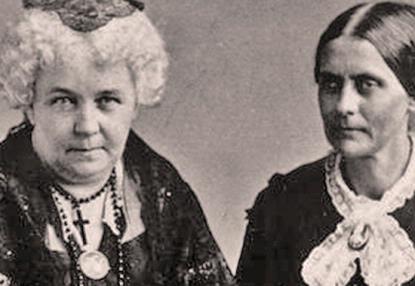
Every book I write is a learning experience, an opportunity to gain new information, insights, and interpretations, with every book I discover fascinating people, places, events, and ideas. Here are three of my discoveries from my immersion in the lives of Elizabeth Cady Stanton and Susan B. Anthony and their legendary friendship that fueled and sustained the nineteenth-century fight for women’s rights.
First, I was intrigued by their ubiquitous use of war language, words such as: “ammunition,” “bullets,” “enemy,” “combat.” A phenomenon, I think, that reflects their acute awareness of the scope of their unprecedented undertaking.
What, I have been asked, would Elizabeth Cady Stanton and Susan B. Anthony think about today’s catchphrase “war on women”? Undoubtedly they would be in the thick of things, I reply, remembering Elizabeth’s description of Susan arriving at her house in Seneca Falls, New York with her bag “stuffed with facts . . . . statistics . . . reports,” which would prompt them to “get out our pens and write articles . . . a petition . . . letters.”
As for what they would focus their energy on today? I believe that Elizabeth, as she always did, would embrace a wide range of issues, in particular ones that limited women’s autonomy. Susan, I think, would zero in on voter disenfranchisement laws.
Second, I gained a deeper understanding of their friendship.
The conventional explanation of their bond is complementarity. Certainly their different skills meshed together synergistically: “In the division of labor,” Elizabeth explained, “we exactly complemented each other . . . . While she is slow and analytical in composition, I am rapid and synthetic. I am the better writer, she the better critic. She supplied the facts and statistics, I the philosophy and rhetoric.”
But complementarity is about the mechanics of a relationship, not the heartbeat. The essence of their friendship, the heartbeat, was their passionate, unwavering commitment to the Cause, to the fight for women’s rights.
My third discovery is an awestruck appreciation of the depth and breadth of their efforts and contributions. Here are eight highlights:
1. They convinced countless numbers of people of what Frederick Douglass called the “wisdom and truth of the then new gospel of woman’s rights.”
2. They organized and addressed numerous women’s rights conventions, including for twenty-six  years an annual national convention in Washington, D.C.
years an annual national convention in Washington, D.C.
3. They addressed scores of state legislatures and testified before many state and federal legislative committees beginning in 1854 when Elizabeth addressed a New York state legislative committee. Years later when they were still testifying Susan noted that now the legislators were “the sons and grandsons” of previous committee members and that she was “tired of begging for liberty from men not half her age and with not a hundredth of her knowledge of State and national affairs.”
4. They spearheaded a federal suffrage campaign and participated in many state campaigns starting with two in 1867 in New York and Kansas.
5. They created a mountain of written material: addresses, resolutions, petitions, articles, the monumental History of Woman Suffrage, and letters galore.
6. They endured arduous traveling conditions to give lectures throughout the U.S. and in Great Britain on issues affecting women.
7. They founded consequential organizations: the Women’s Loyal National League through which they conducted the first grassroots campaign on behalf of a Constitutional amendment, the Thirteenth; the National Woman Suffrage Association, which merged into the National American Woman Suffrage Association and reformed into the League of Women Voters after ratification of the Nineteenth Amendment; and the International Council of Women where at its first meeting delegates from seven countries and from fifty-three different women’s organizations met for eight days in what Elizabeth called “a splendid agitation.” Today the ICW is headquartered in Lasaunne, Switzerland.
8. They modeled an activist friendship in which their shared commitment trumped their egos; their combined sense of humor and repartee foiled their critics, inspired their supporters, and leavened their own spirits; and their mutual respect and loyalty inoculated them against dissension and sustained them throughout the long struggle.
Along with all the historic women I have written about, including Fannie Lou Hamer, Frances Perkins, Dorothea Dix, Mary McLeod Bethune—Elizabeth Cady Stanton and Susan B. Anthony are touchstones for me. Why? Because they are great company—witty, bold, brilliant, irreverent, indomitable, invigorating, empowering, and inspiring. But more importantly, they are an invaluable reference point for me to reflect on friendship, and activism, and social justice, and strategies, and perseverance, and the fight for the rights of women everywhere in the world.
Photos top to bottom:
Photograph of Susan B. Anthony and Elizabeth Cady Stanton taken in the early 1870s by Napoleon Sarony. National Woman’s Party Records, Manuscript Division, Library of Congress, LC-MSS-34355
International gathering of woman suffrage advocates in Washington, D.C., 1888; seated (left to right) Alice Scotchard (England), Susan B. Anthony (United States), Isabella Bogelot (France), Elizabeth Cady Stanton (United States), Matilda Joslyn Gage (United States), and Baroness Alexandra Gripenberg (Finland). Matilda Joslyn Gage was co-author with Stanton and Anthony of the first three volumes of the History of Woman Suffrage. Courtesy of the Library of Congress, Washington, D.C.


